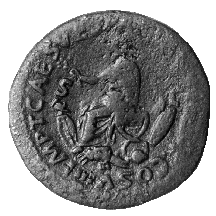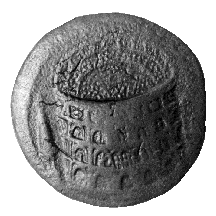



(84) Titus - AE sestertius, A.D. 80, 21.83 g. (inv. 93.023).
Obverse: Titus seated l. amid arms, holding branch in r.; S(ENATVS)- C(ONSVLTO):
by decree of the Senate; IMP(ERATOR) T(ITVS) CAES(AR) VESP(ASIANVS) AVG(VSTVS)
P(ONTIFEX) M(AXIMVS) TR(IBVNICIA) P(OTESTATE) P(ATER) P(ATRIAE) CO(N)S(VL)
VIII: Imperator Titus Caesar Vespasianus Augustus, pontifex maximus,
with tribunician power, father of the country, consul for the eighth
time.
Reverse: The Flavian Amphitheater.
Provenance: Harlan Berk, 1993.
Bibliography: H. Mattingly and E.A. Sydenham, The Roman Imperial Coinage
II: Vespasian to Hadrian (London 1926) 110; P.V. Hill, The Monuments
of Ancient Rome as Coin Types (London 1989).
The most well-known landmark in Rome, the Flavian Amphitheater, better known
by its medieval name, the Colosseum, was begun by Vespasian in A.D. 71 on
land reclaimed for the people from an artificial lake in the gardens of
Nero's Golden House. Work on it was continued by Titus, who dedicated it
in A.D. 80 with opening games lasting 100 days. The largest amphitheater
in antiquity, it could hold 50,000 spectators and was used for the most
popular types of entertainment at the time, beast fights and gladiatorial
contests. The bird's-eye view of the Colosseum on the reverse of this sestertius
of Titus, issued to celebrate the opening, shows the amphitheater packed
with people. To the left is the tall, conical fountain known as the Meta
Sudans, which stood in the vicinity.
Titus seated amid captured arms, a general reference to his successful military
campaigns, replaces the usual portrait head or bust on the obverse.
C.L.L.



All contents copyright (c) 1996.
Lawrence University
All rights reserved.